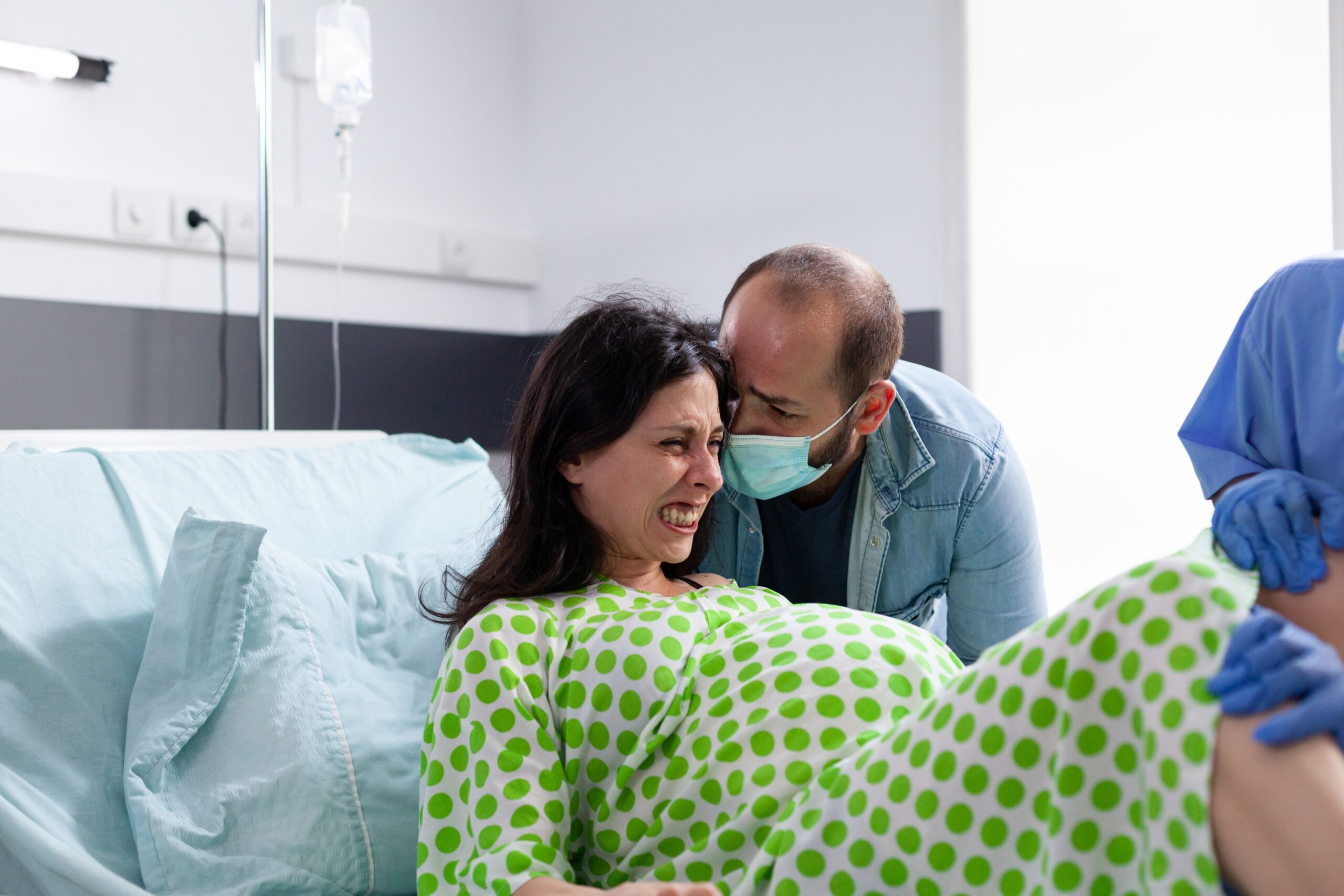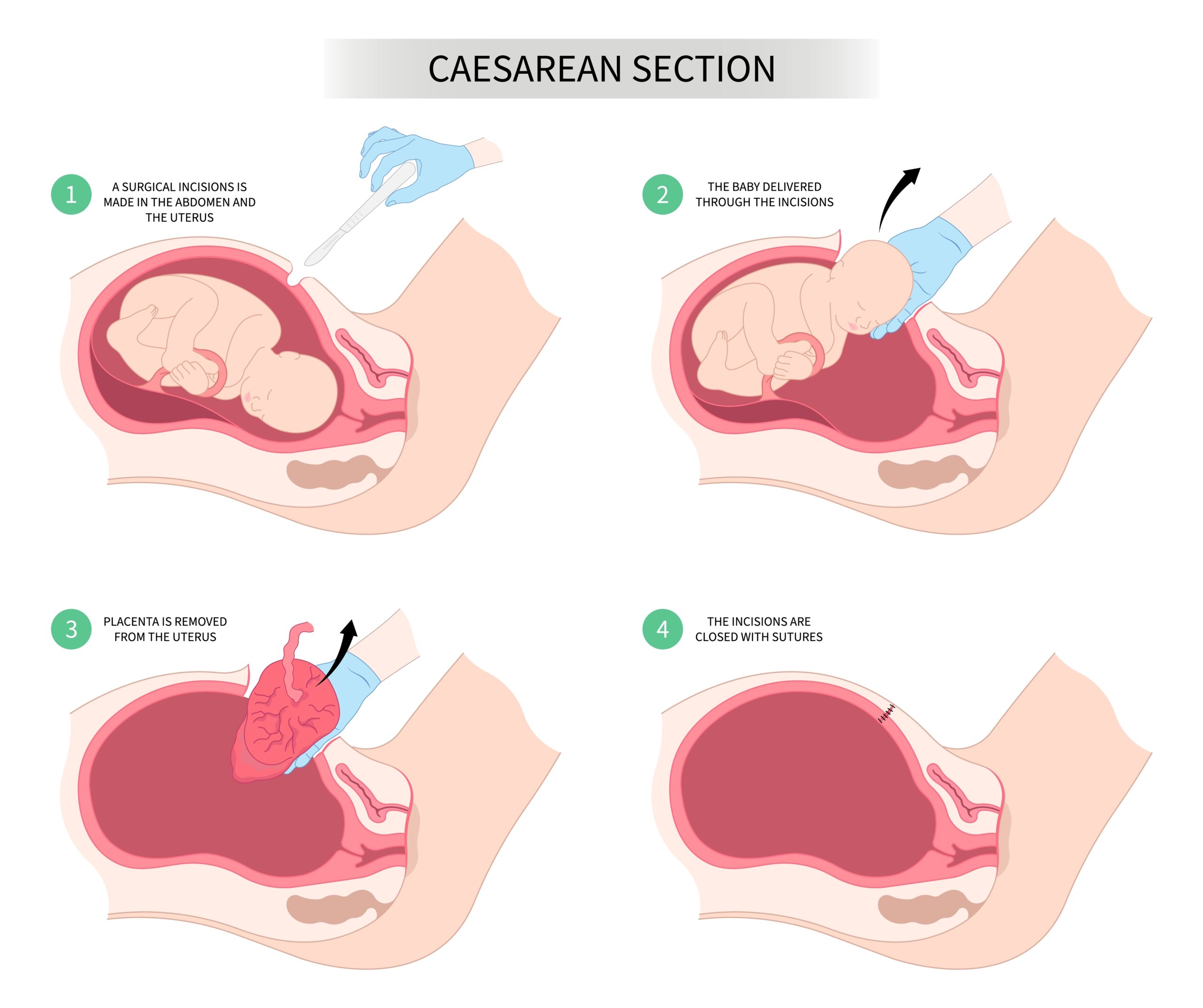Childbirth is a process during which a pregnant woman delivers a child through a series of contractions. It should happen between 37th and 42th week of pregnancy. It can be divided into three stages. The first stage begins when childbirth starts and ends with full cervix dilation.
The second stage starts right after the first one and ends with the delivery of a child. During the third stage, the placenta detaches itself from the uterine wall and is delivered through the birth canal. Those stages describe the most common type of birth, which is vaginal delivery. Other types of birth include: C-section (caesarian birth), VBAC (vaginal birth after caesarian) and assisted vaginal birth.

As you get closer to your due date, you may experience some physical signs suggesting your body is preparing to give birth. These usually come weeks before childbirth. Most of them are only visible in obstetric examination, but some can be spotted by the naked eye or even felt by you. Those signs include:
In a vaginal birth, a child is delivered through a muscular canal connecting the uterus to the outside world called the birth canal. Its duration varies from 14 to 21 hours if it’s your first childbirth or about 7 to 14 hours for the next one.
There are numerous advantages![]() of a successful vaginal birth, such as decreased hospital stay time compared to other types of delivery, quicker physical recovery, higher chance of successful breastfeeding initiation, improved baby’s hormonal functions, better immunity, temperature regulation, and an increase in exploratory behaviors. This type of delivery can be divided into three stages.
of a successful vaginal birth, such as decreased hospital stay time compared to other types of delivery, quicker physical recovery, higher chance of successful breastfeeding initiation, improved baby’s hormonal functions, better immunity, temperature regulation, and an increase in exploratory behaviors. This type of delivery can be divided into three stages.
This is the longest part of childbirth. It takes 8-18 hours![]() for women who are giving birth for the first time and about half that time for any subsequent childbirth. During this stage, a pregnant woman experiences regular, moderately painful contractions in about 5-7 minute intervals. Those contractions are your uterus trying to push the baby out of your body.
for women who are giving birth for the first time and about half that time for any subsequent childbirth. During this stage, a pregnant woman experiences regular, moderately painful contractions in about 5-7 minute intervals. Those contractions are your uterus trying to push the baby out of your body.
The fetal presenting part (part of your child’s body that will be born first) pushes against your uterine cervix, shortening and dilating it. It starts slowly and is called a latent phase of the first stage of labor. Then, after reaching a dilation of about 5 cm, the active phase begins, and progress accelerates until full dilation of about 10cm. The first stage of childbirth ends here, and your child is starting to emerge.
The second stage of childbirth starts with a full 10 cm dilation and ends with the delivery of a newborn child. If it’s your first child, this part may take up to 3 hours but usually takes about 60 minutes; this time shortens to about 30 minutes for women who had previously given birth.
Contractions will continue throughout this stage. You may push alongside them using your abdominal muscles. In the past, doctors believed that women should start pushing as soon as the uterine cervix achieves full dilation, but nowadays,evidence suggests![]() that it should be delayed until a woman feels the urge to push as it is associated with a better overall state of a newborn. The best approach to pushing is to do what feels natural for you, as there is no universal method.
that it should be delayed until a woman feels the urge to push as it is associated with a better overall state of a newborn. The best approach to pushing is to do what feels natural for you, as there is no universal method.![]()
Your doctor may advise you to avoid pushing and holding your breath for an arbitrary number of seconds as prolonged breath-holding may negatively influence blood flow in your placenta, thus giving less oxygen to your baby.
Your baby will most commonly be positioned head first and rotated 90 degrees relative to you. As the second stage starts, your child’s head will slowly descend to your pelvis, and after going through its most narrow point, the baby will rotate to most commonly face your back. Then, the head will be born. Your baby will bend its neck backward and rotate again, now facing one of your thighs, making it easier for its shoulders to be born.
After both shoulders are out, the hard part is done. The rest of the baby will most likely come out within the following few contractions. You should be able to hold your baby immediately. However, that may vary depending on the hospital’s procedure. You may also feed the baby as soon as you want, ideally within the first hour of its life.
It’s the quickest stage of childbirth. Within 5 to 30 minutes after your child is born, the placenta should detach itself from the uterine wall and come out of the birth canal the same way the baby was delivered.
You may deliver the placenta by yourself or be given an injection of a hormone that contracts your womb and helps you with placenta delivery. You should talk to your midwife about both options before labor and choose the option that suits you best. The option that does not include injection is called physiological management; the other option is called active management.
If you decide to go with physiological management and the placenta won’t detach itself within 30 minutes, you’ll be advised to switch to active management as waiting too long increases the chances of bleeding. Active management makes the third stage of childbirth quicker and decreases the risk of heavy bleeding. Still, it is associated with some side effects![]() like nausea, vomiting, increased afterbirth pains, blurred vision, cardiac arrhythmias, seizures, confusion, and hallucinations.
like nausea, vomiting, increased afterbirth pains, blurred vision, cardiac arrhythmias, seizures, confusion, and hallucinations.

The caesarian section is a method of delivery that completely bypasses the natural birth canal. Baby is instead delivered through an incision in your abdomen and uterine wall. It is performed when a vaginal delivery would put the baby’s or mother’s health at risk. Examples of such situations include:

If this is your first pregnancy, you may be wondering what will happen to your body after giving birth. Here is a review of those changes from the first few hours to the few weeks after birth.
Immediately after giving birth, you will probably feel painful contractions called afterpains. They are a good thing as they keep you from bleeding too much by putting pressure on the blood vessels of your uterus. They may persist for a few days after delivery, especially during breastfeeding, because of the contraction-inducing hormone that is released when you feed your baby.
Up to 6 weeks after delivery, blood, mucus, and uterine tissues will flow out of your vagina. At first, this discharge will be bright red, resembling a heavy period. About 5 to 7 days after birth, they should change their color to brownish-red, later becoming dark-yellow or white as wounds in your birth canal gradually heal. If you are bleeding too much, feel dizzy, or experience pelvic pain and tenderness, contact your physician immediately, especially if you also have a fever.
Childbirth can damage your pelvic floor muscles, limiting your ability to hold your pee. Roughly one in three![]() women experience urinary incontinence three months after pregnancy. In the first few days after delivery, ice the perineal area and get plenty of rest to help them recover. Wear sanitary pads and keep the area clean to avoid infections during that time. You may also perform pelvic floor exercises to strengthen your muscles and help them recover quicker.
women experience urinary incontinence three months after pregnancy. In the first few days after delivery, ice the perineal area and get plenty of rest to help them recover. Wear sanitary pads and keep the area clean to avoid infections during that time. You may also perform pelvic floor exercises to strengthen your muscles and help them recover quicker.
Pain and swelling around your anus are symptoms of hemorrhoids, an occasional complication of childbirth. To ease the pain they cause, use a hemorrhoid cream or wipe the area with pads soaked in numbing agents. Soaking your anus in warm water for 15 minutes should also help.